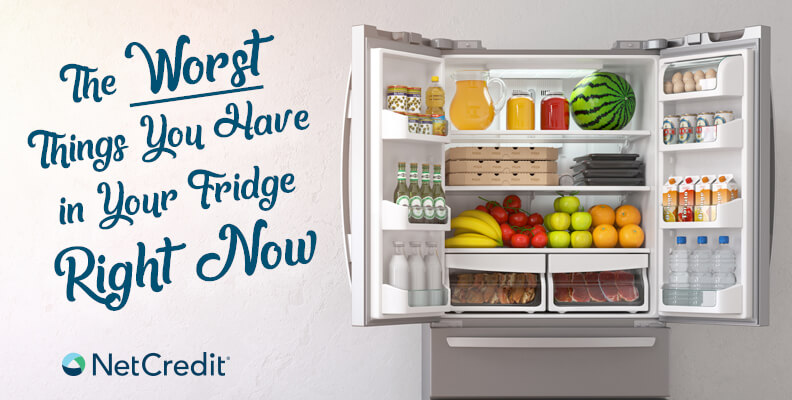Lettuce gone bad? Molding bread? Browning apples? Despite our best intentions to use all the food we buy, we inevitably end up throwing out spoiled items that we didn’t have time to use or that got shoved to the back of the refrigerator.
It’s exasperating when this happens, not to mention it’s a strain on your budget. It’s estimated that Americans throw away more than $165 billion dollars’ worth of food each year — that’s about 300 lbs. and $2,200 wasted per household.1
Make today the day you clean out your fridge for good and start being a savvy food saver. We’ve compiled a list of items to toss that are probably taking up valuable space in your fridge, and collated tips on what you should and shouldn’t be keeping chilled.
Make a Clean Sweep
1. Expired Condiments
Bottles of ketchup, jars of mayonnaise, salad dressing and all those other various sauces and marinades often haunt your refrigerator longer than they should. Double-check the expiration dates and toss anything that’s bad.
Most condiments are fine to eat a little way beyond their expiration date, but if you’re looking at months past instead of just days or weeks it’s time to pitch.
2. Leftovers
Whether from takeout or home-cooked meals, leftovers are perfect for saving money on food. However, there is a short window of when those leftovers are still good to eat. We suggest sticking to the five-day rule, and of course, if you can’t remember when you put it in the fridge, it’s best to just throw it out.
3. Raw Meat
If you’re planning on making an entrée with meat, you’ll want to make sure you cook it within two days of purchasing. Poultry, fish and ground meat are particularly susceptible to spoiling at a faster rate than other cuts, like steaks or chops. Plus, they tend to take on the flavor and smell of other items sitting in your fridge when left for too long.
4. Fruits and Vegetables
Some fruits and vegetables are hardier than others. Check your fridge for items like lettuce, tomatoes and berries (strawberries, raspberries, blackberries): these are more delicate and more likely to spoil faster. If they been sitting in there for a while, it’s probably time to throw them out.
Keep These Items Out of the Refrigerator
1. Coffee
While freezing can help beans last longer, keeping them in the fridge will only serve to ruin the taste. Coffee needs a dry, dark, and preferably airtight space for optimum freshness.
2. Bread
Contrary to popular belief, keeping bread in the refrigerator will decrease, not increase, its shelf life. Similar to coffee, bread keeps best in a cool dry place.
3. Avocados
Avocados are quite delicate — once they’re ripe, they’re best eaten within a day. Otherwise they start to go bad and refrigerating them won’t help. Leave them out on the counter to ripen.
4. Bananas
Similar to avocados, bananas are happiest when left at room temperature. Refrigeration does not help them ripen and will turn the peels an unappetizing brown color.
5. Melons
Pre-chopped melon should always be stored in the fridge, but if you’re buying whole (watermelon, cantaloupe, honeydew) keep out at room temperature to achieve the best flavor.
6. Onions
The humidity in your refrigerator can turn onions soft and moldy quite quickly. You should store these in a dark, dry and most importantly, cool place. This will discourage sprouting and keep them fresher for longer.
7. Peppers
Throwing bell peppers in the fridge is ideal if they’re already ripe (orange to yellow color), since the coolness stops them from ripening any further. But with less ripe varieties (green to red color), leave them out at room temperature.
8. Tomatoes
Cherry, grape, beefsteak, roma… there are numerous types of tomatoes, but they all have one thing in common: refrigeration causes them to become wrinkly and mealy. Keep your tomatoes at room temperature for the best flavor and texture.
Keeping your fridge free of untouched leftovers and spoiled produce takes some forethought and meal planning. But starting with a cleaned-out fridge and armed with knowledge about what should and shouldn’t be refrigerated, you can help avoid your food and money going to waste.
References:
1Pini, P. (April 20, 2017). 10 Shocking Food Waste Statistics. Retrieved April 12, 2018, from http://www.theswagusa.com/2017/04/20/10-shocking-food-waste-statistics/
2Nick, J. (April 12, 2016). 50 Foods You May Not Need to Refrigerate. Retrieved April 12, 2018, from https://www.rodalewellness.com/food/50-foods-you-may-not-need-to-refrigerate






